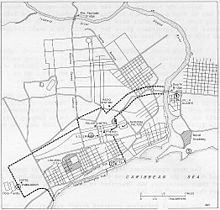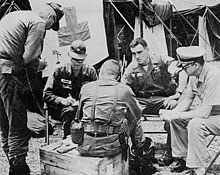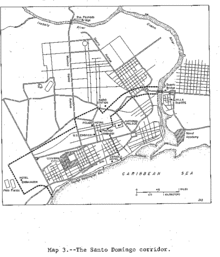- United States occupation of the Dominican Republic (1965–1966)
-
United States occupation of the Dominican Republic Part of the Cold War 
General Robert York during the occupation.Date April 28, 1965 – September 1966 Location Santo Domingo, Dominican Republic Result United States victory, Juan Bosch excluded from Presidency, election of Joaquín Balaguer. Belligerents  United States
United States
Inter-American Peace Force:
 Brazil
Brazil
 Honduras
Honduras
 Paraguay
Paraguay
 Nicaragua
Nicaragua
 Costa Rica
Costa Rica
 El Salvador
El Salvador
 Dominican Armed Forces Training Center
Dominican Armed Forces Training Center
 (SIM) Dominican Military Intelligence Service
(SIM) Dominican Military Intelligence Service Dominican Republic
Dominican Republic
Supported by:
 Cuba
CubaCommanders and leaders  Lyndon B. Johnson
Lyndon B. Johnson
 Robert York
Robert York Juan Bosch
Juan Bosch
 Francisco Caamaño
Francisco CaamañoStrength 42,000 U.S. Marines and Paratroopers
1,130 Brazilian soldiers
250 Honduran soldiers
184 Paraguayan soldiers
160 Nicaraguan soldiers
21 Costa Rican military police officers
3 El Salvadoran staff officers
Unknown SIM and CEFA Soldiers5,000 Casualties and losses United States:
44 killed
283+ wounded
IAPF:
17 wounded[1]2,500 killed
100 captured
3,000 wounded
- 3,500 Dominican civilians were killed during the conflict.
- This occupation should not be confused with the United States occupation of the Dominican Republic (1916–1924).
The second United States occupation of the Dominican Republic began when the United States Marines Corps entered Santo Domingo on April 28, 1965. They were later joined by most of the United States Army's 82nd Airborne Division and its parent XVIIIth Airborne Corps. The intervention ended in September 1966 when the 1st Brigade of the 82nd Airborne, the last remaining American unit in the country, was withdrawn. The occupation occurred at the same time that the United States was starting its military role in Vietnam.
Contents
Background
After a period of political instability following the assassination of long-time Dominican dictator Rafael Trujillo in 1961, candidate Juan Bosch, a founder of the anti-Trujilloist Dominican Revolutionary Party (PRD), was elected President in December, 1962 and inaugurated in February 1963.
The Bosch administration was very much an oddity in Dominican history up to that point: a freely elected, liberal, democratic government that expressed concern for the welfare of all Dominicans, particularly those of modest circumstances, those whose voices had never really been heard before in the National Palace[citation needed]. The 1963 constitution guaranteed civil and individual rights, and endorsed civilian control of the military. These and other changes, such as land reform, struck conservative landholders and military officers as radical and threatening, particularly when juxtaposed against three decades of somnolent authoritarianism under the Trujillo Regime. The hierarchy of the Catholic Church also resented the secular nature of the new constitution, in particular its provision for legalized divorce. The hierarchy, along with the military leadership and the economic elite, also feared communist influence in the republic, and they warned of the potential for "another Cuba". The result of this concern and opposition was an U.S. supported military coup d'état on September 25, 1963.
The coup effectively negated the 1962 elections by installing a civilian junta, known as the "Triunvirato", dominated by the Trujullistas remnants. The initial head of the Triumvirate was Donald Reid C. The Triumvirate never succeeded in establishing its authority over competing conservative factions both inside and outside the military; it also never convinced the majority of the population of its legitimacy. The widespread dissatisfaction with Reid and his government, coupled with lingering loyalties to Bosch, produced a revolution on May 16.
Wessin controlled the Centro de Entrenamiento de las Fuerzas Armadas (Armed Forces Training Center or "CEFA"), an elite group of about 2,000 highly trained infantry. Stationed at the San Isidro Air Base, it was unlike the regular army units: it was supplied with tanks, recoilless rifles and artillery, as well as its own attack aircraft. It was a quasi-independent organization, originally established by Ramfis Trujillo, the son of the former dictator, and was formed to protect the government and keep watch over the national guard, navy and air force. Elías Wessin had stated: "The Communist doctrine, Marxist-Leninist, Castroite, or whatever it is called, is now outlawed."[2]
Subsequently, power was turned over to a civilian triumvirate. The new leaders quickly abolished the constitution, declaring it "nonexistent". The two years that followed were filled with strikes and conflicts.
Donald Reid Cabral, who now found himself at the head of the junta, was unpopular with most of the high-ranking officers in the military for his attempt to cut back on their privileges. He suspected that some or all of these officers would try to overthrow him in the spring of 1965. Hoping to forestall a coup, Reid, on 24 April 1965, dispatched his Army Chief of Staff General Marcos Rivera to cancel the commissions of four conspirators. The four officers not only failed to surrender, but seized a military camp northwest of Santo Domingo, and captured the Chief of Staff.
Immediately the Dominican Revolutionary Party and 14th of June Revolutionary Party put large numbers of armed civilians into the streets, resulting in the creation of unruly armed squads, known loosely as "Comandos". Well-armed bands of teenagers (Los Tigres) swarmed through Santo Domingo shooting at the police. The Dominican Popular Movement distributed Molotov cocktails to the crowds, and the rebel military established defensive positions at the Duarte Bridge.
The pro-Bosch rebels, known as "Constitutionalists" for their focus on restoring the constitutionally elected president, took to the streets, swiftly seizing the national palace and the government radio and television stations in the capital, Santo Domingo and demanding Bosch's return. Colonel Francisco Caamaño and Colonel Manuel Ramón Montes Arache were the leaders of the Constitutionalists. Reid was captured at the presidential palace by rebel forces commanded by Francisco Caamano Deno. Chief of the Armed Forces General Wessin y Wessin now stepped into Reid's vacant position and became the de facto head of state.
Bosch, still in exile in Puerto Rico, was able to convince Jose Rafael Molina Urena, a party leader, to become the provisional president until Bosch could return to the Dominican Republic. The military loyal to the Reid junta and opposed to the Constitutionalists adopted the word Loyalist.
In the days that followed, Constitutionalists clashed with internal security agents and the right-wing military elements of the CEFA. By 26 April 1965, armed civilians outnumbered the original rebel military regulars. Radio Santo Domingo, now fully under rebel control, began to call for more violent actions and for killing of all the policemen.
Both sides were heavily armed and civilians were caught in the crossfire. Washington began immediate preparations for the evacuation of its citizens and other foreign nationals who might wish to leave the Dominican Republic.
The extent of participation by "communists or Castroites", including the Dominican 14 June Revolutionary group, has been disputed.
Constitutionalist Provisional President Molina Urena and Colonel Caamano asked the US ambassador for US intervention to stop the Dominican Air Force attacks on the Constitutionalist-held areas. The US ambassador refused. Utterly dismayed by this rejection, Molina Urena relinquished his position as Provisional President to Colonel Caamano. In San Isidro, Loyalists generals chose Air Force Colonel Pedro Bartolome Benoit to head a new Loyalist junta.
On 28 April the Dominican Air Force resumed its bombing of rebel positions in Santo Domingo and armed rebel civilians overran a police station and summarily executed the policemen. Of the 30,000 Dominican soldiers, airmen and police at the start of the civil war, General Wessin now commanded less than 2,400 troops and only 200 national police.
Initial US military action was limited to the evacuation by United States Marines of U.S. and other civilians from the city of Santo Domingo. A landing zone was established at the Hotel Embajador in the then Western outskirts of Santo Domingo for this purpose.
The Loyalists failed to regain control of Santo Domingo, and a demoralized CEFA retreated to its base at San Isidro on the east side of the Ozama River. General Wessin and the last leader of the deposed governing regime, Donald Reid - best known as "El Americano" (The American) – both requested U.S. intervention.
Occupation
 HQ United States Forces and IAPF and quartering of health services during the occupation of Santo Domingo :
HQ United States Forces and IAPF and quartering of health services during the occupation of Santo Domingo :
1. Headquarters, U.S. Forces,
2. Headquarters, IAPF,
3. Company D, 307th Medical Battalion, at Colegio Maria Auxiliadora,
4. Company C, clearing station,
5. 15th Field Hospital,
6. Company C at Camp Randall.U.S. President Lyndon B. Johnson, convinced of the defeat of the Loyalist forces and fearing the creation of "a second Cuba"[3] on America's doorstep, ordered U.S. forces to restore order. The decision to intervene militarily in the Dominican Republic was Lyndon Johnson's personal decision. All civilian advisers had recommended against immediate intervention hoping that the Loyalist side could bring an end to the civil war. President Johnson, however, took the advice of his Ambassador in Santo Domingo, W. Tapley Bennett, who pointed out the inefficiency and indecisiveness of the Dominican military leaders. Bennett suggested that the US interpose its forces between the rebels and those of the junta, thereby effecting a cease-fire. The United States could then ask the Organization of American States to negotiate a political settlement between the opposing factions.
Chief of Staff General Wheeler told CINCLANT General Palmer that "Your unannounced mission is to prevent the Dominican Republic from going Communist."[4] Citing as an official reason for the invasion the need to protect the lives of foreigners, none of whom had been killed or wounded, a fleet of 41 vessels was sent to blockade the island, and an invasion was launched by Marines and elements of the United States Army's 82nd Airborne Division on 29 April. U.S. Also, around 75 members of E company of the 7th Special Forces Group were deployed. Ultimately, 42,000 soldiers and marines were ordered to the Dominican Republic. The United States along with the Organization of American States (OAS) formed an inter-American military force to assist in the intervention in the Dominican Republic.
The Constitutionalist forces resisted the invasion. By mid-afternoon of April 30, a cease-fire, facilitated by the Papal Nuncio, was negotiated.
On May 5 the Act of Santo Domingo was signed by Colonel Benoit (Loyalist), Colonel Caamaño (Constitutionalist) and the OAS Special Committee. The Act provided for a general cease-fire, recognition of the International Security Zone, agreement to assist relief agencies, and the sanctity of diplomatic missions. The Act set the framework for later negotiations but failed to stop all of the fighting. Constitutionalist snipers continued to shoot at US forces, however, major fire fights between the Dominican factions did subside for a time.
Denied a military victory, the Constitutionalist rebels quickly had a Constitutionalist congress elect Caamano president of the country. US officials countered by backing General Imbert. On May 7, Imbert was sworn in as president of the Government of National Reconstruction. The next step in the stabilization process, as envisioned by Washington and the OAS, was to arrange an agreement between President Caamaño and President Imbert to form a provisional government committed to early elections. However, Caamaño refused to meet with Imbert until several of the Loyalist officers, including Wessin y Wessin, were made to leave the country.
On 13 May General Imbert began Operation LIMPIEZA (Cleanup) and his forces were successful in eliminating pockets of rebel resistance outside Ciudad Nueva and silencing Radio Santo Domingo. Operation CLEANUP ended on 21 May.
By May 14 the Americans, in establishing a "safety corridor" connecting the San Isidro Air Base and the "Duarte" Bridge to the Embajador Hotel and United States Embassy in the center of Santo Domingo, had essentially sealed-off the Constitutionalist area of Santo Domingo. Road blocks were established and patrols ran continuously. Some 6,500 people from many nations were evacuated to safety. In addition, the US forces airlifted in large relief supplies for Dominican nationals.
By mid-May, a majority of the OAS voted for Operation PUSH AHEAD, the reduction of United States forces and their replacement by an Inter-American Peace Force (IAPF). Inter-American Peace Force (IAPF) was formally established on May 23. The following troops were sent by each country: Brazil - 1,130, Honduras - 250, Paraguay - 184, Nicaragua - 160, Costa Rica - 21 military police, and El Salvador - 3 staff officers. The first contingent to arrive was a rifle company from Honduras which was soon backed by detachments from Costa Rica, El Salvador, and Nicaragua. Brazil provided the largest unit, a reinforced infantry battalion. Brazilian General Hugo Alvim assumed command of the OAS ground forces, and on 26 May the US forces began to withdraw.
The fighting continued until 31 August 1965 when a truce was declared. Most American troops left shortly afterwards as policing and peacekeeping operations were turned over to Brazilian troops, but some U.S. military presence remained until September 1966.
Facing ongoing threats and attacks, including a particularly violent attack at the Hotel Matum in Santiago de los Caballeros, Camaaño accepted an agreement imposed by the USA government. The Dominican Provisional President, Garcia Godoy, sent Colonel Caamano as the Military Attaché to the Dominican Embassy to the UK.
In 1966, former President Joaquín Balaguer (Trujillo's 4th puppet president) was elected over Juan Bosch - with the overt support of the US government. Bosch would never regain power. Relative political stability followed as the initially oppressive yet highly politically crafty Balaguer would go on to dominate Dominican politics for twenty-two years.
Casualties
Military
- A total of 44 American soldiers died, 27 in action. 172 were wounded in action.[5]
- Of the IAPF personnel, 6 Brazilians and 5 Paraguayans were wounded in action.[5]
Dominican
- An estimated 6,000 to 10,000 Dominicans died, mostly civilians.[5]
Notable participants
- Mitchell WerBell III, OSS/CIA operative, soldier of fortune.
- James Kimsey, founder of America Online.
- Bruce P. Crandall, went on to receive Medal of Honor for actions in Vietnam.
- Drew Dennis Dix, went on to receive Medal of Honor for actions in Vietnam.
See also
- History of the Dominican Republic
- Johnson Doctrine
- That Was the Year That Was
- United States occupation of Haiti
References
- ^ Washington Center of Foreign Political Research, National Support of International Peacekeeping and Peace Observation operations (Washington, D.C.: Johns Hopkins University, Feb 70), pp. 289-313.
- ^ Draper, Theodore: "The Dominican Crisis", Commentary magazine Vol. 40 • December 1965 • No. 6
- ^ Stephen G. Rabe, "The Johnson Doctrine", Presidential Studies Quarterly 36
- ^ "Foreign Relations of the United States, 1964–1968 Volume XXXII, Dominican Republic; Cuba; Haiti; Guyana, Document 43". US Dept. of State. http://history.state.gov/historicaldocuments/frus1964-68v32/d43. Retrieved 2011-04-26.
- ^ a b c [1]
Further reading
- McPherson, Darrell G.. The Role of the Army Medical Service in the Dominican Republic. Washington, D.C.: Office of the Surgeon General, Department of the Army. http://www.history.army.mil/books/contingency/domrep/index.htm. - full text
- Warnock, A. Timothy. Dominican Crisis: Operation POWER PACK. Short of War: Major USA Contingency Operations edited by A. Timothy Warnock. Air Force History and Museums Program, 2000. pp 63–74.
External links
- 82nd Airborne History Page - Operation Power Pack: A "Road" Test for the 82nd Airborne Division
- Dominican Republic PSYOP, reportage from SGM Herbert A. Friedman (ret)
Major armed conflicts involving the United States Armed Forces listed chronologicallyInternal Shays' Rebellion · Whiskey Rebellion · Dorr Rebellion · Mormon War · Bleeding Kansas · Utah War · Civil War · Indian Wars · Brooks–Baxter War · Coal Creek War · Homestead Strike · Battle of Blair Mountain · Bonus Army
International Revolutionary War · Quasi-War · First Barbary War · War of 1812 · Second Barbary War · First Sumatran Expedition · Second Sumatran Expedition · Ivory Coast Expedition · Mexican–American War · First Fiji Expedition · Second Opium War · Second Fiji Expedition · Korean Expedition · Spanish–American War · Philippine–American War · Boxer Rebellion · Banana Wars · Border War · World War I · Russian Civil War · World War II · Korean War · Vietnam War · Invasion of the Dominican Republic · Invasion of Grenada · Lebanese Civil War · Invasion of Panama · Gulf War · Somali Civil War · Bosnian War · Kosovo War · Afghanistan War · Iraq War · War in North-West Pakistan · Libyan Civil War · Lord's Resistance Army insurgency
Related articles List of conflicts in the U.S. · List of wars involving the U.S. · Timeline of U.S. military operations · Length of U.S. participation in major wars · Overseas expansion · Military history · Covert regime-change actions · Casualties of war
United States intervention in Latin America Policy Monroe Doctrine (1823) · Platt Amendment (1901) · Roosevelt Corollary / Big Stick ideology (1904) · Good Neighbor policy (1933) · Dollar DiplomacyWars Mexican-American War (1846-1848) · Spanish–American War (1898) · Border War (1910–18) · United States involvement in the Mexican Revolution (1916–1919)Overt actions
and occupationsParaguay expedition (1858) · Separation of Panama from Colombia (1903) (Hay–Bunau-Varilla Treaty) · Occupations of Honduras · Occupation of Nicaragua (1912–1933) · Occupation of Veracruz (1914) · Occupation of Haiti (1915–1934) · Occupation of the Dominican Republic (1916–1924) · Occupation of the Dominican Republic (1965–1966) · Invasion of Grenada (1983) · Invasion of Panama (1989)Covert actions Disputed claims Other Cuban Missile Crisis (1962)Foreign policy of the United States · Latin America – United States relationsCategories:- American military occupations
- Wars involving Brazil
- Wars involving Costa Rica
- Wars involving the Dominican Republic
- Wars involving El Salvador
- Wars involving Honduras
- Wars involving Nicaragua
- Wars involving Paraguay
- Wars involving the United States
- History of the Dominican Republic
- Military history of the Dominican Republic
- United States–Caribbean relations
- Conflicts in 1965
- Anti-communism
- 1965 in the Dominican Republic
- 1966 in the Dominican Republic
- Presidency of Lyndon B. Johnson
- Cold War conflicts
- United States Marine Corps in the 20th century
- Dominican Republic–United States relations
Wikimedia Foundation. 2010.


